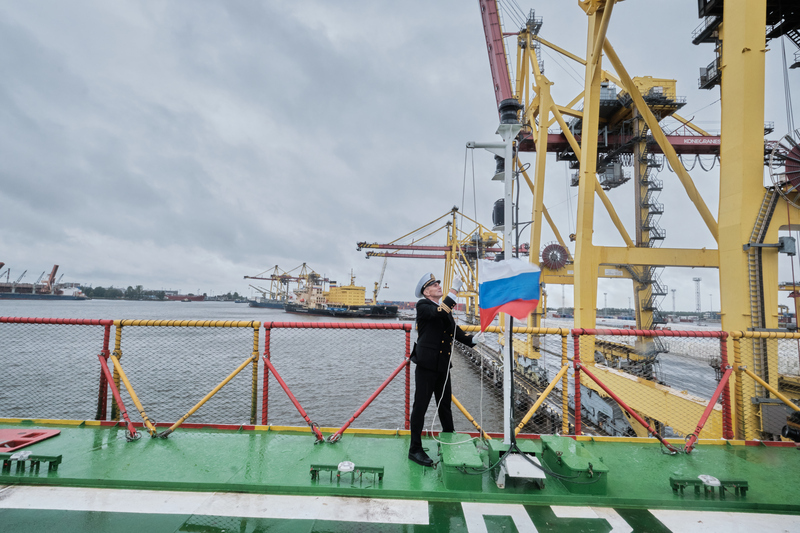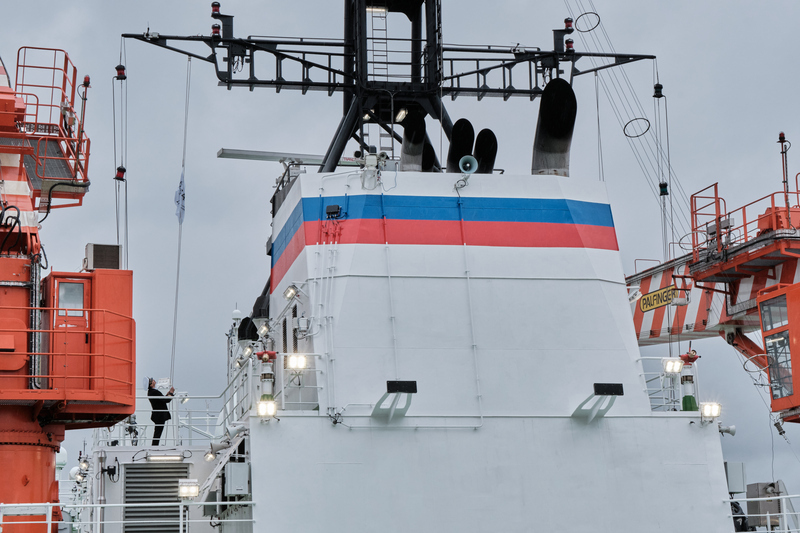
The Severny Polyus (North Pole) ice-resistant self-propelled platform, Project 00903, built by Admiralteiskie Verfi (a company of United Shipbuilding Corporation, USC) has left for its first voyage today, 1 September 2022. Prior to it, a flag-hoisting ceremony was held on the research vessel in the presence of Igor Shumakov, head of the Federal Service for Hydrometeorology and Environmental Monitoring (Roshydromet), and Aleksandr Makarov, Director of the Arctic and Antarctic Research Institute (AARI), AARI says in its press release.
The Severny Polyus platform is intended for round-the-year comprehensive scientific research in high latitudes of the Arctic Ocean. The vessel comes to the research area by water breaking through thin ice and then, having freezed in the ice, can drift along with it for up to two years.
The ship will carry the North Pole 41 expedition to the Central Arctic as a continuation of the legendary national programme of drift ice stations stated in 1937 by four polar scientists lead by Ivan Papanin.
“In mid-September, the expedition will start in Murmansk and sail eastwards to the New Siberian Islands. In about two weeks the platform is to arrive at the site of freezing. In early October, the 41st Arctic drift ice station will commence its operation. A research camp will be set up around the platform with some studies to be conducted onboard the vessel equipped with 15 scientific laboratories,” said Aleksandr Makarov.
According to the head of Roshydromet, Russian scientists will first be able to conduct research involving a ship in high latitudes of the Arctic Ocean and carry out long-term studies in safe conditions. Data from the North Pole are essential for studying climate and ice, for planning lanes on the Northern Sea Route and for ensuring hydrometeorological safety.
The platform will conduct geological, acoustic, geophysical and oceanographic observations particularly needed for ensuring navigational safety on the Northern Sea Route. “The hull will be fitted with sensors taking into account ice pressure impact. That is of great importance since one of our institute’s key tasks is to provide forecasts for navigation on the Northern Sea Route. In view of the growing traffic in the Arctic seas, the role of hydrometeorological support ensuring safe shipping is getting increasingly high. Efficiency of escort operations is also of high significance as each route can be passed with higher or lower energy consumption, which has an impact on end cost of cargo transportation,” said Aleksandr Makarov.
“Over the recent decade, the shipbuilding companies have built and delivered 19 research ships of various purposes. An ice-resistant self-propelled platform for the Arctic research has now joined them. The uniqueness of the platform is in its ability to arrive at the research area without icebreaker assistance, drift in the water area of the Arctic Ocean up to two years and return to the port … The platform’s lifetime is 30-35 with an interim overhaul. So, Russian polar explorers will have a reliable base until at least 2050,” said Denis Manturov, Minister of Industry and Trade, according to the Ministry’s Telegram channel. He says the Strategy for the development of the shipbuilding industry util 2035 foresees construction of 13 research ships.
“There are five research ships under construction today and underway is the consideration of awarding a contract to domestic shipyards for a series of three large research ships intended for operation in open parts of the oceans based on the design developed by Vympel bureau. Besides, five research ships Akademik Sergey Vavilov, Akademik Nikolay Strakhov, Akademik Mstislav Keldysh, Akademik Ioffe, Akademik M.A. Lavrentyev) will undergo modernization,” said Denis Manturov.
Th Severny Polyus is the third ship in the research and expedition fleet of AARI. The shipbuilding contract between the Federal Service for Hydrometeorology and Environmental Monitoring (Roshydromet), Vympel Design Bureau and Admiralteiskie Verfi shipyard was signed in April 2018. Model tests were held in AARI ice basin. The vessel was launched in December 2020 and left for sea trials on 21 May 2022. The Severny Polyus was put into operation in August 2022.
The platform specifications: LOA: 83.1 m; breadth: 22.5 m; draft: 8.6 m; displacement: 10,400 t; power propulsion unit: 4,200 kW; speed: at least 10 knots; hull strength - Arc8; fuel endurance: about 2 years; service life: at least 25 years; crew - 14; scientific personnel - 34. Class notation: KM(*) Arc5[1] AUT1-C HELIDECK-F Special purpose ship by Russian Maritime Register of Shipping.
Related links:
Admiralteiskie Verfi shipyard reports successful completion of North Pole platform contractor sea trials >>>>
Photos provided by the Arctic and Antarctic Research Institute (AARI):









